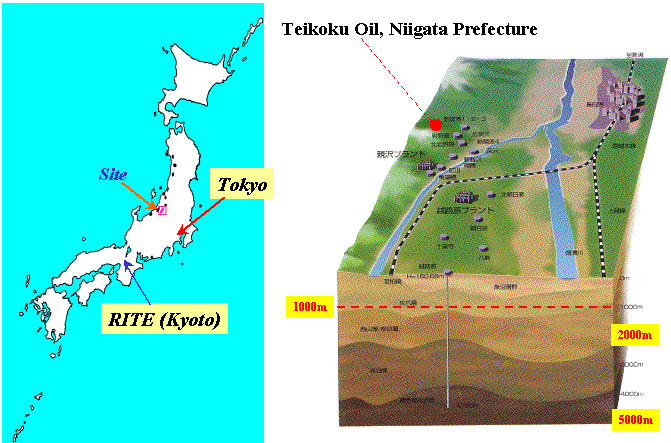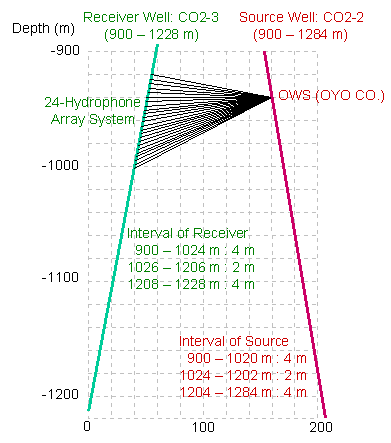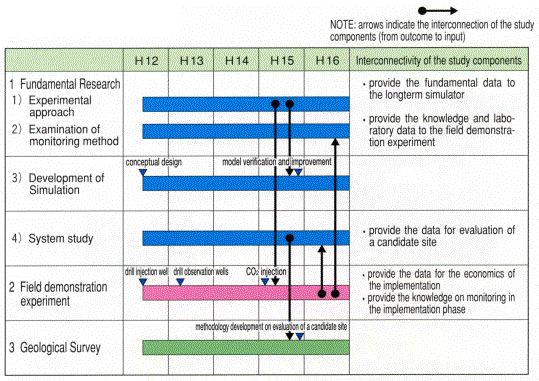
CO2 Geological Sequestration Project
Last Updated: June 27, 2003
Research Institute of Innovative Technology for the Earth (RITE) is responsible for a five-year project of "Research and Developement of Geological Sequestration Technology for Carbon Dioxide" (2000-2004). The project aims to establish a technology that provides stable, safe and long-term geological sequestration of carbon dioxide emitted from large-scale sources in Japan. Research and development are carried out in cooperation with Engineering Advancement Association of Japan (ENAA). |
| Overview of the CO2 Geological Sequestration System | |
 Note: This figure is explaining the implementation of the CO2 geological sequestration technology. |
|
| Basic Research | |
|
|
Experimental studies have been conducted at the laboratory level to collect data such as effects of CO2 injection on seismic wave properties, the solubility of carbon dioxide in aquifers and the interaction between carbon dioxide, formation water, and rocks. These data are to be used in evaluating the long-term stability and safety for geological sequestration. |
|
|
Monitoring methods have been investigated in order to study monitoring technologies that might be applicable in the future. The review was made on the basis of the reports and materials presented in the Carbon Capture Project gRisk Assessment Workshoph at Nottingham UK in May 2002 and in the Intergovernmental Panel on Climate Change gWorkshop on carbon dioxide capture and storageh at Regina Canada in November 2002. |
|
|
Simulation R&D is intended to develop a simulator for prediction of the long-term behaviors of carbon dioxide sequestered underground,and to establish a method for an EIA. A simulator for the storage of natural gas (GEM-UGS) has been selected for the core code. This simulator can deal with many kinds of natural phenomena. However, it appears that several phenomena are not to be simulated by the core code, although they may be important for determining the long-term behavior of carbon dioxide in the subsurface. Consequently,element modules will be added to the core code. |
|
|
A system study has been conducted with two objectives:to identify the environmental impact and safety levels for the cases of possible combinations among locations of large-scale sources of carbon dioxide, means of recovery and transportation, and storage points by using multi-dimensional, quantitative evaluation indices and to elucidate the significance of the geological sequestraton technology in terms of cost, safety, social acceptance and others factors among a variety of optional countermeasure against global warming. |
| Injection Experiment | |
Japan has ...
|
|
Purpose of Experiment
|
|
Injection Parameter
|
|
 Field Test Site (Active Gas Field) |
|
 CO2 Monitoring at the Test Site |
|
 Source and Receiver Geometry of Seismic Tomography |
|
Plan of Monitoring
|
|
| Geological Study | |
The geological study aims to establish the procedures and methodology of geo-technical analysis and evaluation for the carbon dioxide sequestration, and to provide a useful guideline for the site selection. Geological study also aims to do the preliminary study on the site selection, by compiling the existing geological information of the offshore areas surrounding Japan. |
|
| Schedule | |
 |
|
Inquiry
CO2 Geological Sequestraion Project
TEL: +81-774-75-2309@FAX: +81-774-75-2316
- Related Laboratory: CO2 Sequestration Research Group
